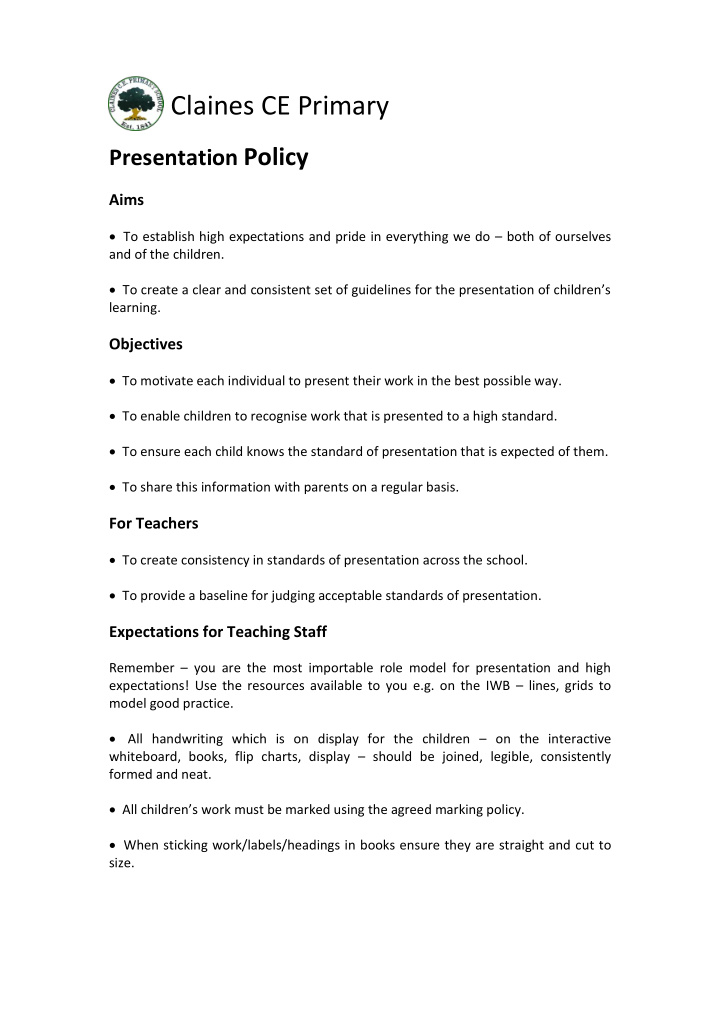



Claines CE Primary Presentation Policy Aims To establish high expectations and pride in everything we do – both of ourselves and of the children. To create a clear and consistent set of guidelines for the presentation of children’s learning. Objectives To motivate each individual to present their work in the best possible way. To enable children to recognise work that is presented to a high standard. To ensure each child knows the standard of presentation that is expected of them. To share this information with parents on a regular basis. For Teachers To create consistency in standards of presentation across the school. To provide a baseline for judging acceptable standards of presentation. Expectations for Teaching Staff Remember – you are the most importable role model for presentation and high expectations! Use the resources available to you e.g. on the IWB – lines, grids to model good practice. All handwriting which is on display for the children – on the interactive whiteboard, books, flip charts, display – should be joined, legible, consistently formed and neat. All children’s work must be marked using the agreed marking policy. When sticking work/labels/headings in books ensure they are straight and cut to size.
Expectations for Children Pencils should be used in all books and draft work. Margins in books and on paper should be drawn in pencil if required. Pens should only be used for display work (not maths), where the teacher judges the child’s handwriting to be sufficiently neat and fluent. Pens must be fibre tip. No ballpoint, biros or felt pens should be used. Felt pens should not be used in exercise books for underlining or illustrations although they can be used on paper at the teacher’s discretion. No drawing or writing on the cover of books is allowed by and children must not doodle in their books. Any piece of work that does not meet the standards set out by the Presentation Policy will be have to be rewritten. Expectations for Handwriting Basic cursive script will be taught in foundation stage and developed through the school with the expectation that by the time children leave Key Stage 1, they will be writing in joined cursive script. Cursive script is the preferred style for all worksheets and hand-outs. Use the right size letters when you need to – capital letters at the start of sentences and for proper nouns. Handwriting is taught for at least 15 minutes per week and as an integral part of spelling and phonics lessons. Good examples of handwriting from the children will be displayed in the classroom as a reference for others. Expectations for Layout The long date is written at the top; then leave a single line and write the Learning Objective (WALT) on the next line below. It may be appropriate for the teacher or teaching assistant to write these in the children’s books. The date and WALT must be underlined using a pencil and ruler. At the start of a new piece of work, miss a line under the last piece of work, rule off and start on a new line. Don’t leave a blank page. *NB. Children must be allowed time to respond to any marking before they rule off and start on a new line.
Miss a line under the LO and start at the margin. Leave one line between each paragraph. If you make a mistake, draw one neat line, using a ruler, through the mistake and start again – do not over-write or rub out. Write ON THE LINE to the end of the line. Do not write in the margin. Example of Presentation Layout in Mathematics If appropriate, pages can be divided into two with a ruled line. The short date, to be written on the left hand side of the page, the WALT - both should be underlined with a ruler. It may be appropriate for the teacher or teaching assistant to write these in the children’s books. All figures, this includes all mathematical signs and symbols, must be written neatly and clearly with one figure to each square. Each calculation must be clearly numbered to distinguish it from working figures. When using vertical layout, the answer should have ruler lines above and below an answer with the operation sign to the left or right in a separate column. Calculations which involve ‘carrying’ should see the relevant digit written smaller than usual beneath the bottom line.
Examples of Presentation Outcomes of Presentation Policy Children of all abilities are able to present their work to the highest possible standard increasing their confidence and self-esteem. There is consistency across the school in terms of the standard of presentation expected. Progression in presenting work between each class is evident and understood by all children and adults. Monitoring of Presentation Policy The Senior Leadership Team will collect examples of children’s work on a termly basis to ensure that the policy is being implemented consistently. This ensures that the policy leads to good practice in facilitating effective feedback, learning and teaching. Review This policy will be reviewed every 2 years or as required by changes to current legislation. Signed: ……………………………………………………………………. Date ………………………………. (Chair of School Improvement and Curriculum Committee)
Recommend
More recommend